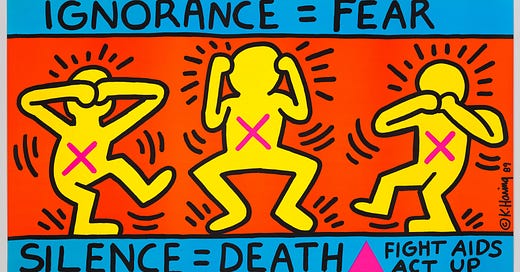Keith Haring: A Legacy That Still Speaks
Keith Haring Died on February 16, 1990—But His Legacy Lives On
Though Keith Haring died exactly 35 years ago, it feels like he is still alive. His bold lines, dancing figures, and radiant hearts remain embedded in our culture. His art still speaks. His activism still inspires. His legacy continues to pulse through murals, protests, and movements that fight for justice today.
Haring was more than an artist—he was a revolutionary. Born into the turbulence of the 1960s, he came of age in an era of civil rights struggles, anti-war protests, and queer liberation. When he arrived in New York City in 1978, the city itself was a canvas—a place where he could merge art with activism. He took to the subways, the streets, and eventually the world, turning his signature style into a universal language of resistance and love.
But it was the AIDS crisis that would define his greatest act of advocacy. Diagnosed with HIV in 1987, he didn’t retreat—he fought harder. His Ignorance = Fear, Silence = Death artwork became one of the defining images of the epidemic. He painted, spoke out, and created the Keith Haring Foundation to fund AIDS research and children’s programs, knowing his time was running out. He used his last years to make sure the world couldn’t look away.
And here we are, 35 years later.
If Keith were here today, he would be painting in protest of book bans, marching for trans rights, and calling out politicians who weaponize fear against marginalized communities. He would be designing graphics to push back against disinformation, supporting global HIV funding like PEPFAR, and using every medium available to combat the apathy and injustice that still persist.
His work reminds us that activism isn’t just policy—it’s culture. It’s visibility. It’s the refusal to be erased. In a time when LGBTQ+ rights, reproductive freedom, and public health are under attack, Haring’s approach to activism—bold, unapologetic, and accessible—offers a roadmap for resistance.
“It seems to me the only thing to do in the world is to “do” something. The “doing” is what the world is.” Keith Haring, Journals, May 4, 1982.
Keith once said, “It seems to me the only thing to do in the world is to do something.” That simple but urgent truth defined his life. He believed that art should be for everyone—not locked away in galleries, but part of daily life, part of the struggle for justice. He painted on walls, t-shirts, and even hospital beds. He made his work impossible to ignore because he knew that art, at its best, is a call to action.
His legacy challenges us: How do we use our own voices, platforms, and creativity to fight for what matters? How do we keep pushing when progress feels fragile? How do we make sure the next generation has something to inherit other than silence?
Thirty-five years later, his art still radiates urgency. His message still demands to be heard. His fight is not over.
Join me on February 25, 2025, for Keith Haring’s Legacy in Today’s World: A Conversation About HIV Activism at Center for Strategic and International Studies (CSIS) | 🎤 Featuring an interview with Radiant author Brad Gooch | 📌 [RSVP here]





Thanks JIRAIR for this wonderful piece remembering Keith Harlng- one of our favorite artists. We wish we could be with you on the 25th but can’t. Will forward to friends. Keep up the great work. What a time we live in. Who could have imagined this is where we’d be today.
Loved listening to this! Thank you!